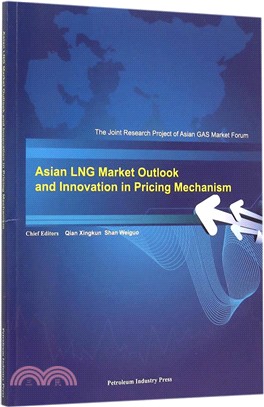商品簡介
目次
相關商品
商品簡介
錢興坤、單衛國所*的《亞洲LNG市場展望及價格機制創新(英文版)》Based on analyzing the market fundamentals and pricing mechanism in Asia, specifically in the 5 LNC consuming areas, the report put forward measures to safeguard supply to the Asian LNC Market and reduce Asian Premium. Excess emphasis on supply security and expanding imports will inevitably expose Asian gas buyers to more risks associated with international gas supply and unreasonable higher import price,both of which are the most urgent issues to be resolved jointly by Asian gas buyers.The report put forward a system of '3-D' counter-measures.The first dimension is dealing with gas industrial chain,which is posed of 4 side measures, i.e., supply expansion, demand streamlining, trade flexibility and rational pricing.The second dimension is geological dimension, dealing with both measures within a country and regiorial cooperation.The third dimension is timing for actions, dealing with both short term and long term measures.
目次
Chapter 1 Major Findings and Key Messages
Chapter 2 Analysis of Asian Natural Gas( LNG) Market Fundamentals
2.1 Features of Asian NaturaIGas(LNG)Market
2.1.1 Demand Side Analysis
2.1.2 Supply Side Analysis
2.1.3 The Features of Asia-Pacific Natural Gas( LNG) Market
2.2 Future Development of Asia-Pacific Natural Gas( LNG) Market and Its Role in the World Market
2.2.1 Natural Gas Demand in Asia-Pacific Keep Growing
2.2.2 Gas Supply & Demand Gap in Asia-Pacific Is Widening
2.2.3 More Countries in Asia Turn to Import LNG
2.2.4 Rising Demand Attracts more Suppliers
2.3 The Challenges of Securing Supply to Asian Natural Gas( LNG) Mark
2.3.1 Local Gas Resource Is Insufficient
2.3.2 More Import Means More Risk of Supply Interruption
2.3.3 Heavy Burden Still Exists Due to Asian Premium
2.3.4 Infrastructure Constraints Brings Risks for Sustained and Stable Supply
Chapter 3 Analysis on Natural Gas Market Fundamentals in Major Asian Countries and Regions
3.1 China
3.1.1 Gas Consumption
3.1.2 Gas Supply
3.1.3 Infrastructure
3.1.4 Demand and Supply Outlook
3.1.5 Regulatory Policies
3.1.6 Challenges for Supply
3.2 India
3.2.1 Historical Demand and Supply Conditions in India Market
3.2.2 Natural Gas Market Structural Features
3.2.3 Natural Gas Infrastructure Conditions in India
3.2.4 Natural Gas Regulatory Policies
3.2.5 India Natural Gas Demand and Supply Outlook
3.2.6 Actions for Developing a Robust Natural Gas Industry in India
3.3 Japan
3.3.1 Supplyand Demand
3.3.2 Infrastructure
3.3.3 Regulatory Policies
3.3.4 Supply and Demand Outlook
3.3.5 Challenges for Supply Security
3.4 Korea
3.4.1 Supplyand Demand
3.4.2 Market Structural Features
3.4.3 Infrastructural Conditions
3.4.4 Analysis of Natural Gas Regulatory Policies
3.4.5 Natural Gas Demand Projection
3.5 Taiwan(China)
3.5.1 The Structure of Taiwan' s Energy Supply and Demand
3.5.2 Taiwan' s Natural Gas Supply and Demand
3.5.3 The Current Status of Taiwan' s Natural Gas Infrastructure
3.5.4 Natural Gas Administration Policies
3.5.5 Taiwan' s Natural Gas Supply and Demand Outlook
Chapter 4 Analysis of the Asian and World Gas Price Formation
4.1 Research on the World Gas Pricing Formation
4.1.1 The Overview of the Global Gas Pricing Mechanisrus
4.1.2 The Trend of the Global Gas Pricing Formation
4.1.3 Gas Pricing in the United States
4.1.4 Gas Pricing in the European Union
4.2 Research on Gas Pricing Mechanisms in Major Asian Consumers
4.2.1 Pricing Mechanism in the Asia-Pacific
4.2.2 China
4.2.3 India
4.2.4 Japan
4.2.5 Korea
4.2.6 Taiwan(China)
Chapter 5 Measures to Safeguard Supply to the Asian LNG Market and Reduce Asian Premium
5.1 Supply Expansion
5.1.1 Enhancing Exploration and Production of Gas Resources within the Region
5.1.2 Cooperating in Oversea Gas Exploration and Production
5.1.3 Diversifying Gas Import Sources
5.1.4 Involving in Global LNG Projects including Upstream
5.1.5 Increasing Dialogue between Consumers and Suppliers
5.1.6 Cost Reduction of Gas Supply through Better Management and New Technology
5.2 Measures on Demand Side
5.2.1 Price Mechanism to Balance Supply & Demand and to Reflect Market Value
5.2.2 Policy to Liberalize Gas Market and Introduce Competition
5.2.3 Better Power Mix and Efficient Use of Gas
5.2.4 Cooperative Measures
5.3 Flexibility of Long-Term Contract Terms
5.3.1 Elimination of Destination Clauses, Innovation of Swap and Re-sale in Long-Term Contracts
5.3.2 Adjusting Pricing Mechanism of Long-Term Contracts
5.4 Elimination of Asian Gas Premium by Forming Price Benchmark
5.5 Enhancing Cooperation
5.5.1 Enhancing Infrastructure for the Development of Integrated Regional Market
5.5.2 Regional Buyer Cooperation
5.5.3 Sharing of Information
Chapter 2 Analysis of Asian Natural Gas( LNG) Market Fundamentals
2.1 Features of Asian NaturaIGas(LNG)Market
2.1.1 Demand Side Analysis
2.1.2 Supply Side Analysis
2.1.3 The Features of Asia-Pacific Natural Gas( LNG) Market
2.2 Future Development of Asia-Pacific Natural Gas( LNG) Market and Its Role in the World Market
2.2.1 Natural Gas Demand in Asia-Pacific Keep Growing
2.2.2 Gas Supply & Demand Gap in Asia-Pacific Is Widening
2.2.3 More Countries in Asia Turn to Import LNG
2.2.4 Rising Demand Attracts more Suppliers
2.3 The Challenges of Securing Supply to Asian Natural Gas( LNG) Mark
2.3.1 Local Gas Resource Is Insufficient
2.3.2 More Import Means More Risk of Supply Interruption
2.3.3 Heavy Burden Still Exists Due to Asian Premium
2.3.4 Infrastructure Constraints Brings Risks for Sustained and Stable Supply
Chapter 3 Analysis on Natural Gas Market Fundamentals in Major Asian Countries and Regions
3.1 China
3.1.1 Gas Consumption
3.1.2 Gas Supply
3.1.3 Infrastructure
3.1.4 Demand and Supply Outlook
3.1.5 Regulatory Policies
3.1.6 Challenges for Supply
3.2 India
3.2.1 Historical Demand and Supply Conditions in India Market
3.2.2 Natural Gas Market Structural Features
3.2.3 Natural Gas Infrastructure Conditions in India
3.2.4 Natural Gas Regulatory Policies
3.2.5 India Natural Gas Demand and Supply Outlook
3.2.6 Actions for Developing a Robust Natural Gas Industry in India
3.3 Japan
3.3.1 Supplyand Demand
3.3.2 Infrastructure
3.3.3 Regulatory Policies
3.3.4 Supply and Demand Outlook
3.3.5 Challenges for Supply Security
3.4 Korea
3.4.1 Supplyand Demand
3.4.2 Market Structural Features
3.4.3 Infrastructural Conditions
3.4.4 Analysis of Natural Gas Regulatory Policies
3.4.5 Natural Gas Demand Projection
3.5 Taiwan(China)
3.5.1 The Structure of Taiwan' s Energy Supply and Demand
3.5.2 Taiwan' s Natural Gas Supply and Demand
3.5.3 The Current Status of Taiwan' s Natural Gas Infrastructure
3.5.4 Natural Gas Administration Policies
3.5.5 Taiwan' s Natural Gas Supply and Demand Outlook
Chapter 4 Analysis of the Asian and World Gas Price Formation
4.1 Research on the World Gas Pricing Formation
4.1.1 The Overview of the Global Gas Pricing Mechanisrus
4.1.2 The Trend of the Global Gas Pricing Formation
4.1.3 Gas Pricing in the United States
4.1.4 Gas Pricing in the European Union
4.2 Research on Gas Pricing Mechanisms in Major Asian Consumers
4.2.1 Pricing Mechanism in the Asia-Pacific
4.2.2 China
4.2.3 India
4.2.4 Japan
4.2.5 Korea
4.2.6 Taiwan(China)
Chapter 5 Measures to Safeguard Supply to the Asian LNG Market and Reduce Asian Premium
5.1 Supply Expansion
5.1.1 Enhancing Exploration and Production of Gas Resources within the Region
5.1.2 Cooperating in Oversea Gas Exploration and Production
5.1.3 Diversifying Gas Import Sources
5.1.4 Involving in Global LNG Projects including Upstream
5.1.5 Increasing Dialogue between Consumers and Suppliers
5.1.6 Cost Reduction of Gas Supply through Better Management and New Technology
5.2 Measures on Demand Side
5.2.1 Price Mechanism to Balance Supply & Demand and to Reflect Market Value
5.2.2 Policy to Liberalize Gas Market and Introduce Competition
5.2.3 Better Power Mix and Efficient Use of Gas
5.2.4 Cooperative Measures
5.3 Flexibility of Long-Term Contract Terms
5.3.1 Elimination of Destination Clauses, Innovation of Swap and Re-sale in Long-Term Contracts
5.3.2 Adjusting Pricing Mechanism of Long-Term Contracts
5.4 Elimination of Asian Gas Premium by Forming Price Benchmark
5.5 Enhancing Cooperation
5.5.1 Enhancing Infrastructure for the Development of Integrated Regional Market
5.5.2 Regional Buyer Cooperation
5.5.3 Sharing of Information
主題書展
更多
主題書展
更多書展今日66折
您曾經瀏覽過的商品
購物須知
大陸出版品因裝訂品質及貨運條件與台灣出版品落差甚大,除封面破損、內頁脫落等較嚴重的狀態,其餘商品將正常出貨。
特別提醒:部分書籍附贈之內容(如音頻mp3或影片dvd等)已無實體光碟提供,需以QR CODE 連結至當地網站註冊“並通過驗證程序”,方可下載使用。
無現貨庫存之簡體書,將向海外調貨:
海外有庫存之書籍,等候約45個工作天;
海外無庫存之書籍,平均作業時間約60個工作天,然不保證確定可調到貨,尚請見諒。
為了保護您的權益,「三民網路書店」提供會員七日商品鑑賞期(收到商品為起始日)。
若要辦理退貨,請在商品鑑賞期內寄回,且商品必須是全新狀態與完整包裝(商品、附件、發票、隨貨贈品等)否則恕不接受退貨。

















![Wicked [Movie Tie-In]:魔法壞女巫電影原著](https://cdnec.sanmin.com.tw/product_images/006/006285284.jpg)






